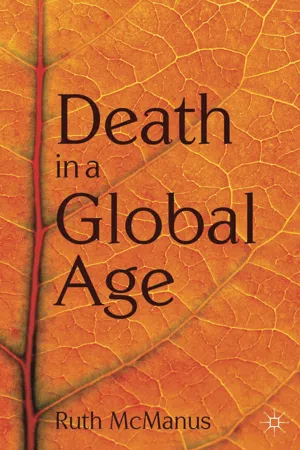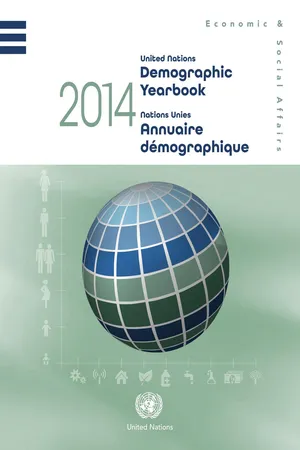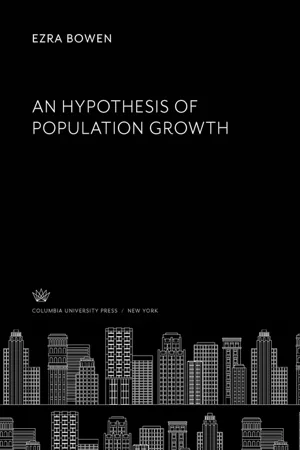Social Sciences
Death Rates
Death rates refer to the number of deaths occurring in a specific population over a given period of time, often expressed as a rate per 1,000 or 100,000 individuals. They are a key measure in understanding the health and well-being of a population, and are used to assess the impact of diseases, accidents, and other factors on mortality within a community.
Written by Perlego with AI-assistance
Related key terms
1 of 5
8 Key excerpts on "Death Rates"
- eBook - ePub
Population Geography
A Systematic Exposition
- Mohammad Izhar Hassan(Author)
- 2020(Publication Date)
- Routledge India(Publisher)
11 Mortality and life tableMortality, or the occurrence of death, is another component of population change. Unlike fertility, mortality is more stable and predictable, and is less prone to unique fluctuations. While fertility behaviour of a population depends on a set of social, demographic, psychological and economic factors, mortality is a biological phenomenon. Death control is universally acceptable in all societies of the world. The Death Rates have, therefore, undergone a more rapid decline than that of the birth rates. It is this decline in the Death Rates, rather than any increase in the birth rates, which has been responsible for rapid growth in the world population during the recent past. Temporal changes in Death Rates not only affect the size of a population but also its age composition, which has important bearings on the social, economic and demographic conditions in an area. The study of mortality is, therefore, useful for analysing the current demographic conditions as well as for determining the prospect of potential change in the mortality conditions in the future. The analysis of mortality is of vital importance to planners and policy makers in the provision of basic health care services in any population. The analytical study of mortality can be described as the study of ‘the risk of dying’ in different populations or different groups in a population.The meaning of the term ‘death’ does not involve any ambiguity and, therefore, it facilitates the measurement of mortality. The UN and WHO have defined the term as ‘the permanent disappearance of all evidence of life at any time after birth’.The vital registration or civil registration system provides data on deaths in a country. However, in a country where such registration system is absent or inadequate, statistics on mortality are obtained from periodic censuses and sample surveys. It should, however, be noted that periodic censuses do not provide data on mortality directly. Estimates on mortality are indirectly derived using the age-sex distribution of population of two consecutive censuses. In sample surveys, however, when a direct question on the occurrence on deaths is included estimates on mortality are available. - eBook - PDF
- Ruth McManus(Author)
- 2017(Publication Date)
- Red Globe Press(Publisher)
During a woman’s childbearing years, from the onset of menstruation to menopause, a woman is capable of bearing more than twenty children. Fecundity , or the maximum possible amount of childbearing, is sharply reduced by cultural norms, finances and personal choice. The crude death rate is calculated by taking the deaths in a particular year and dividing the number by the total mid-year population. Morbidity rates can mean either the incidence rate or the prevalence rate of a particular disease or disorder in a population, usually expressed as cases per 100,000 or per million in one year. Demographic rates reveal how particular ways of living make certain ways of dying more prevalent. Allan Kellehear (2007) gives a useful exam-ple of using demographic and epidemiological material to find patterns in personal experiences of dying. He compresses the eons of human life into distinct styles of living that are linked explicitly to styles of dying, and hence to demographic rates. For example, in ancient times of hunter-gatherer living there would be many births but also many deaths, with the vast majority a result of infection or injury. The demographic rates of that time would have been of high birth and Death Rates – morbidity would have shown high rates of infection and trauma and lower rates of degenerative disease and famine. As ways of living transformed from hunter-gatherer to sedentary, agrarian-based living, there would have been a transformation in the demographic rates. High birth rates would have remained, but there would be lower Death Rates from infection and trauma from hunting, while Death Rates for degenerative diseases and famine would have increased. If it were possible to gather details about the numbers of people living and Patterns in Life and Death 69 dying, and what they died of, it would have been possible to chart this transformation in ways of living in the demographic trends of the time. - eBook - PDF
Biostatistics
A Foundation for Analysis in the Health Sciences
- Wayne W. Daniel, Chad L. Cross(Authors)
- 2020(Publication Date)
- Wiley(Publisher)
Variables that enter into the picture include age, race, sex, and socioeconomic status. When two populations must be compared on the basis of Death Rates, adjustments may be made to reconcile the population differences with respect to these variables. The same precautions should be exercised when comparing the annual Death Rates for the same community for two different years. 2. Annual specific Death Rates. It is usually more meaningful and enlightening to observe the Death Rates of small, well-defined subgroups of the total population. Rates of this type are called specific Death Rates and are defined as Total number of deaths in a specific subgroup during a year Total population in the specific subgroup as of July 1 ⋅ k where k is usually equal to 1000. Subgroups for which specific Death Rates may be computed include those groups that may be distinguished on the basis of sex, race, and age. Specific rates may be computed for two or more characteristics simultaneously. For example, we may compute the death rate for white males, thus obtaining a race-sex specific rate. Cause-specific Death Rates may also be computed by including in the numerator only those deaths due to a particular cause of death, say, cancer, heart disease, or accidents. Because of the small fraction that results, the base, k, for a cause-specific rate is usually 100,000 or 1,000,000. 3. Adjusted or standardized Death Rates. As we have already pointed out, the usefulness of the crude death rate is restricted by the fact that it does not reflect the composition of the population with respect to certain characteristics by which it is influenced. We have seen that by means of specific Death Rates various segments of the population may be investigated individually. If, however, we attempt to obtain an overall impression of the health of a population by looking at individual specific Death Rates, we are soon overwhelmed by their great number. - No longer available |Learn more
United Nations Demographic Yearbook 2014
Sixty-fifth issue
- United Nations Department of Economic and Social Affairs(Author)
- 2015(Publication Date)
- United Nations Publications(Publisher)
Table 18 -Demographic Yearbook 2014 Table 18 presents deaths and crude Death Rates by urban/rural residence for as many years as possible between 2010 and 2014. Description of variables: Death is defined as the permanent disappearance of all evidence of life at any time after live birth has taken place (post-natal cessation of vital functions without capability of resuscitation). Statistics on the number of deaths are obtained from civil registers unless otherwise noted. For those countries or areas where civil registration statistics on deaths are considered reliable (estimated completeness of 90 per cent or more), the Death Rates shown have been calculated on the basis of registered deaths. The urban/rural classification of deaths is that provided by each country or area; it is presumed to be based on the national census definitions of urban population that have been set forth at the end of the technical notes for table 6. For certain countries, there is a discrepancy between the total number of deaths shown in this table and those shown in subsequent tables for the same year. Usually this discrepancy arises because the total number of deaths occurring in a given year is revised although the remaining tabulations are not. Rate computation: Crude Death Rates are the annual number of deaths per 1 000 mid-year population. Rates by urban/rural residence are the annual number of deaths, in the appropriate urban or rural category, per 1 000 corresponding mid-year population. These rates are calculated by the Statistics Division of the United Nations based on the appropriate reference population (for example: total population, nationals only etc.) if known and available. If the reference population is not known or unavailable the total population is used to calculate the rates. - No longer available |Learn more
- (Author)
- 2014(Publication Date)
- Research World(Publisher)
________________________ WORLD TECHNOLOGIES ________________________ Chapter- 8 Mortality Rate Crude death rate by country Mortality rate is a measure of the number of deaths (in general, or due to a specific cause) in some population, scaled to the size of that population, per unit time. Mortality rate is typically expressed in units of deaths per 1000 individuals per year; thus, a mortality rate of 9.5 in a population of 100,000 would mean 950 deaths per year in that entire population, or 0.95% out of the total. It is distinct from morbidity rate, which refers to the number of individuals in poor health during a given time period (the prevalence rate) or the number of newly appearing cases of the disease per unit of time (incidence rate). One distinguishes: 1. The crude death rate , the total number of deaths per year per 1000 people. As of July 2009 the crude death rate for the whole world is about 8.37 per 1000 per year according to the current CIA World Factbook. 2. The perinatal mortality rate , the sum of neonatal deaths and fetal deaths (stillbirths) per 1000 births. ________________________ WORLD TECHNOLOGIES ________________________ 3. The maternal mortality rate , the number of maternal deaths per 100,000 women of reproductive age in same time period. 4. The infant mortality rate , the number of deaths of children less than 1 year old per 1000 live births. 5. The child mortality rate , the number of deaths of children less than 5 years old per 1000 live births. 6. The standardised mortality rate (SMR)- This represents a proportional comparison to the numbers of deaths that would have been expected if the population had been of a standard composition in terms of age, gender, etc. 7. The age-specific mortality rate (ASMR) - This refers to the total number of deaths per year per 1000 people of a given age (e.g. age 62 last birthday). In regard to the success or failure of medical treatment or procedures, one would also distinguish: 1. - eBook - PDF
Population Estimation and Projection
Methods for Marketing, Demographic, and Planning Professionals
- James Raymondo(Author)
- 1992(Publication Date)
- Praeger(Publisher)
Similar data are available for blacks in addition to the nonwhite category. As is the case with many of the vital rates discussed in this chapter, the problem is not one of difficult calculation but one of data availability. National data for the United States are readily available, but in general one will find that the smaller the level of geography, the less detailed data will be available. Each of the measures of mortality discussed in this section may be employed in the production of population estimates or projections. The crude death rate is the most basic measure of mortality. The CDR is also the easiest to calculate, and it makes the least demanding data require- 28 Population Estimation and Projection ments. It may also be calculated separately for males and females and for different racial groups. The CDR is characterized by a lack of sensitivity as any crude rate is; however, in many applications the lack of sensitivity represented by a crude death rate is not nearly as problematic when measuring mortality as a crude birth rate is in measuring fertility. While age differentials in mortality are worth noting whenever possible, the crude death rate does make a valuable contribution to the measurement of mortality in the production of population estimates or projections, and the CDR remains a robust measure of mortality. There are situations that require detailed mortality data beyond the capacities of the crude death rate, and age specific mortality rates are ideally suited to meet that need. The ASDR is easily calculated, and separate rates may be calculated for males, females, or certain racial groups. The major disadvantage is the stringent data requirements that must be met in order to complete the calculations. Infant mortality rates constitute a specialized type of age specific mortality rate that often make a valuable contribution to the estimation or projection process. - eBook - PDF
- Ezra Bowen(Author)
- 2019(Publication Date)
- Columbia University Press(Publisher)
Birth and death, from the point of view of the individual, are mysteries. Even in this latest day, when purely acci-dental parenthood is losing its sanctity, the birth as well as the death of any individual seems entirely indeterminite. When however, groups of a hundred thousand or more are considered, birth rates and Death Rates become astoundingly definite. Persons interested in such matters predict with-out hesitation—or regret—that, for example, eighteen hun-dred out of each hundred thousand will die during the en-suing year and that twenty-three hundred will be born. Not only may birth rates and Death Rates be predicted by dead reckoning, extrapolation, but the underlying cause, the factor that governs all other causes of fluctuation in birth rates and Death Rates is becoming daily more apparent. 154 - eBook - PDF
- Saw Swee-Hock(Author)
- 2012(Publication Date)
- ISEAS Publishing(Publisher)
81 5 Mortality Trends and Differentials The size and structure of the population at any given time are determined by the interaction of migration, mortality and fertility in the immediate past. While a previous chapter has dealt with migration, this chapter will be devoted to a discussion of mortality trends and differentials among the major races. A general survey of mortality trends from the late 1870s, when death statistics were first made available, will be presented first, followed by a more thorough analysis for the years after World War II. An attempt will also be made to examine the changing position regarding differentials in mortality among the three main races. General Mortality trends In examining the long-term mortality trends we ought to be careful in interpreting the death statistics for the early years because they were probably subject to the progressive improvement in the vital registration system. The doubtful accuracy of population estimates used in the computation of the Death Rates may cast further doubt on the reliability of these rates. Another problem encountered in the analysis of mortality trends is that the annual death statistics of the early period were affected by violent fluctuations resulting from sporadic epidemics and frequent external displacement and replacement of the population caused by local economic depressions and booms. In view of these difficulties, the figures will be presented in terms of quinquennial years, which will enable us to trace the general direction of mortality trends. In Table 5.1 are given the figures pertaining to the annual average deaths and the crude Death Rates for quinquennial years from 1878 onwards. The popu-lation denominator employed in the computation of the crude death rate is taken as the average of the five mid-year populations in each given five-year 82 POPULATION OF SINGAPORE period. An examination of the rates shows that they passed through certain fairly noticeable phases.
Index pages curate the most relevant extracts from our library of academic textbooks. They’ve been created using an in-house natural language model (NLM), each adding context and meaning to key research topics.







